IAC News
IAC News No.131, September 2023
Japan Society of Civil Engineers International Activities Center September 5, 2023 IAC News No.131
International Symposium on Extreme Precipitation and Extreme Flooding
held by the Committee on Hydroscience and Hydraulic Engineering”
After the transition to the new Corona 5 class, JSCE held its first international event using both in-person and remote methods. The event was organized by the Committee on Hydroscience and Hydraulic Engineering with the invitation of M.L. Kavvas, Distinguished Processor, University of California, Davis, who has been working for many years on estimating realistic extreme precipitation and extreme flooding for structural design in the wake of a series of flood damage caused by extreme rainfall events around the world. The symposium was held as follows.
| ・Date and Time: Thursday, April 27, 2023, 1:00 p.m. - 4:00 p.m. ・Location: JSCE Auditorium and webinar ・For more information: Website of Committee on Hydroscience and Hydraulic Engineering (https://committees.jsce.or.jp/hydraulic/node/225) ・General participants: 17 at the venue, 302 in the webinar ・Number of JSCE CPD certificates issued: 128 ・Language: English for the venue, simultaneous English/Japanese interpretation for the webinar |
An outline of the International Symposium is as follows:
1. Background (10 minutes), Toshio Koike (Director, International Center for Water Hazard and Risk Management, Public Works Research Institute)
After a series of floods and new policies that have occurred every year since 2013, the government is promoting “River Basin Disaster Resilience and Sustainability by All,” which is implemented by all parties involved. He explained that Japan has initiated river planning that takes climate change into account, but has yet to reflect extreme phenomena in its planning, showing images of the movement and development of heavy rain fields from the 2015 Kanto and Tohoku torrential rains and the 2016 typhoon rainfall.
2. Keynote Speech (90 minutes) “Recent Advances in Physics-Based Numerical Modeling Approaches to Estimate Extreme Rainfall and Extreme Flooding (PMP/PMF)” M.L. Kavvas, Distinguished Professor, University of California, Davis; Yoshihiko Izeri, Hydrology Laboratory, UC Davis Manager.
The conventional method of estimating maximum possible precipitation was reviewed. Next, the authors discussed two cases: an atmospheric river on the West Coast (a winter weather phenomenon in which moist air from the vicinity of Hawaii flows to the West Coast and brings heavy rainfall) and hurricane rainfall on the East Coast. The method maximizes rainfall and flood flow in two steps by optimizing the shift of atmospheric boundaries and relative humidity. The method was then applied to climate change scenarios to show changes in the frequency of rainfall.
3. Panel Discussion (50 minutes): In addition to Kavvas and Koike, Eiichi Nakakita (moderator, Director and Professor of Disaster Prevention Research Institute, Kyoto University) and Tadashi Yamada (Distinguished Professor of Chuo University) discussed PMP/PMF from the three perspectives of importance, reliability, and future prospects, and offered the following opinions.
- Level 2 in climate change adaptation measures corresponds to PMP/PMF.
- It is important to statistically demonstrate confidence intervals in the forecast.
- Almost all of Professor Kavvas' education in hydrology at a U.S. university in the 1970s was in statistics, while at another he studied the physics of water. Later, he studied atmospheric science collaboratively and was able to develop hydro-meteorological models and estimate physical upper limits.
- There are many in the U.S. who believe that statistical methods can be used to estimate the upper limit, but this is not possible.
- Estimates of precipitation during historical floods that occurred prior to the start of observations yielded results that did not necessarily indicate heavy rainfall.
- Some areas show a 10-year cycle of heavy or light rainfall, while others do not. The ocean is the key.
- If the PMP/PMF is clarified, it will have implications for “River Basin Disaster Resilience and Sustainability by All.”
- The characteristics of the statistical approach can be understood by reproducing ensembles of past events.
Many of the webinar participants listened to the webinar with simultaneous interpretation and commented that they were able to listen to a lecture by a world-leading scientist that they cannot experience without such a special arrangement, that they thought this was a top priority global issue, that they could understand the difference between statistical and physical approaches from the keynote speech and discussions, and that they could understand the general framework of the topic because of the background explanation, even though it was not their specialty. On the other hand, some participants pointed out that the time delay of the simultaneous interpretation bothered understanding, that they could not understand the translation of technical terms, and that there were times when audio did not come through to the microphone.
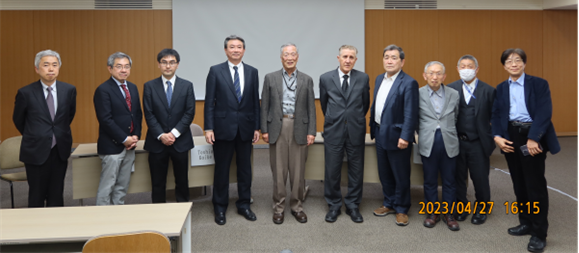
International Symposium officials and audience participants
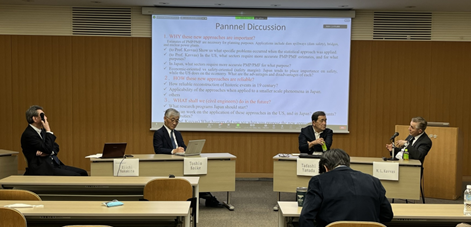
Panel discussion (from left to right: Eiichi Nakakita, Toshio Koike, Tadashi Yamada, M.L. Kavvas)
【Reported by Junichi Yoshitani, Working Secretary for Organizing International Symposium, Committee on
Hyroscoence and Hydraulic Engineering (Professor, Shinshu University)】
Switch Snow-Melting Pits
– A Measure to Ensure Railroad Switches Remain Operational During Snowy and Icy Conditions –
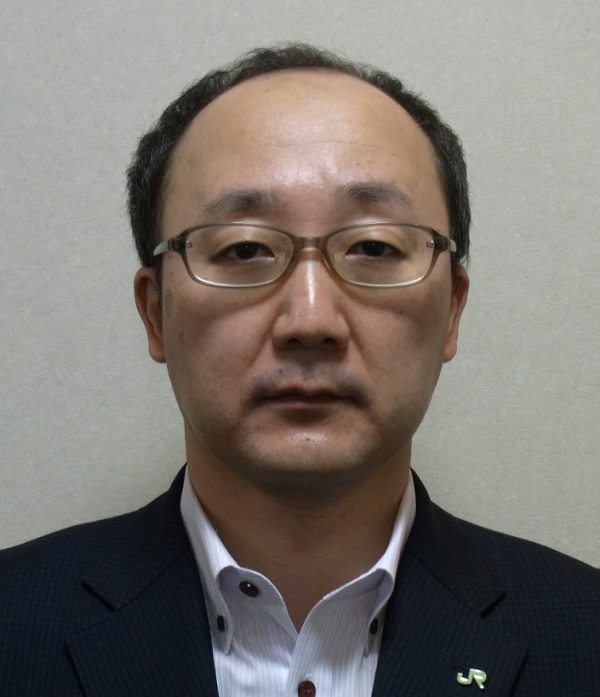
Kazuyoshi Watanabe
(Hokkaido Railway Company)
1. Overview
For us at Hokkaido Railway Company, a company that serves customers in a region with a cold, snowy climate, ensuring the safety and stability of transportation during snowy and icy conditions is a major challenge.
The biggest factor in obstructing stable transportation on the railroads during snowy and icy conditions is railroad switches not operating properly due to snow carried by trains and fallen snow. As a countermeasure, we developed a “switch snow-melting pit” and have continued to make improvements to it to this day.
The biggest factor in obstructing stable transportation on the railroads during snowy and icy conditions is railroad switches not operating properly due to snow carried by trains and fallen snow. As a countermeasure, we developed a “switch snow-melting pit” and have continued to make improvements to it to this day.
The switch snow-melting pit is a recessed area spanning from the front end of the switch to the heel part, with a focus on the moving parts of the switch. The switch snow-melting pit has a structure in which it takes in train-carried snow and fallen snow below the rail, preventing the snow from accumulating on the rail area. Snow accumulated inside the pit is discharged as water through melting the snow with the far-infrared panel heater installed in the pit.
Thanks to the far-infrared panel heater (set temperature of 20°C) installed at the bottom of the pit, snow does not rest on the top of the rail at the switch area, unless there is extreme snowfall.
Approximately 30 years have passed since the switch snow-melting pit was developed, helping to ensure safe and reliable transportation at Hokkaido Railway Company during snowy and icy conditions. The switch snow-melting pit was recognized for its innovation, receiving the FY2022 Infrastructure Maintenance Project Award.
2. Changes in Installation Methods & Development Over the Years
The basic structure of the switch snow-melting pit is installing divided precast reinforced concrete blocks across a length of about three meters in a short timeframe, and then uniting each block with tension using prestressed concrete steel wire.
When the switch snow-melting pit was initially developed, a method to cut the rail and excavate the roadbed of the switch area before installation was adopted. However, to enable installation in a short timeframe on commercial lines thereafter, the installation method was improved to a method in which the side of the installation area was excavated in advance, the blocks tentatively placed down, and the switch snow-melting pit installed through the side-track installation approach in short installation intervals without cutting the rail.
This was later followed by the cast-in-place installation method at newly established lines. With the switch snow-melting pit also installed on viaducts (new and pre-existing installations) and for the Hokkaido Shinkansen between Shin-Aomori and Shin-Hakodate-Hokuto, today, it is installed in 84 locations in Hokkaido. There are also plans for it to be used between Shin-Hakodate-Hokuto and Sapporo for the Hokkaido Shinkansen.
3. Development Timeline
| 1995 | Installed on the Sassho Line at Hokkaido University of Health Sciences Station (rail-cutting installation method) |
| 1996 | Installed on the Hakodate Line at Zenibako Station (side-track installation method) |
| 2001 | Installed on the Soya Line of Kita-Asahikawa Station of Asahikawa Rail Yard (cast-in-place installation method) |
| 2010 | Installed on the Hakodate Line, Soya Line, and Furano Line at Asahikawa Station (cast-in-place installation method, and first adoption on a newly built viaduct) |
| 2015 | Installed for the Hokkaido Shinkansen at Okutsugaru-Imabetsu Station, Kikonai Station, Shin-Hakodate-Hokuto, and Hakodate Rolling Stock Depot Facility (cast-in-place installation method, and first adoption for the Shinkansen) |
| Installed on the Hakodate Line at Kotoni Station (cast-in-place installation method, and first adoption on pre-existing viaduct) |
Switch Snow-Melting Pit
(Installed on the Hakodate Line at Iwamizawa Station)
View of Inside Switch Snow-Melting Pit
【Reported by Kazuyoshi Watanabe, Vice Section Manager, Construction Section, Engineering Affairs Department,
Railroad Business Division, Hokkaido Railway Company】
Committee on Civil Engineering Consultants
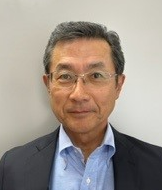
Keiichi Imai
(Chair of Committee on Civil Engineering Consultants)
1. Committee on Civil Engineering Consultants
The Committee on Civil Engineering Consultants aims to clarify how JSCE and society should interact and to help contribute to society through spreading the surveys, research, and results of the consultancy profession and professional services. The Consultant Committee has the following subcommittees, which carry out various activities:
- Citizen Consensus Building Research Subcommittee
- Research Paper Collection Project Subcommittee
- Citizen Networking Research Subcommittee
- Regional Revitalization Research Subcommittee
- Global Civil Engineer Research Subcommittee
2. Subcommittee Activities
Let’s take a look at the main activities carried out this year by the aforementioned subcommittees.
(1) Regional Revitalization Research Subcommittee
The Regional Revitalization Research Subcommittee aims to gather success cases of regional revitalization brought about by building infrastructure and physical spaces, and to pull together content that can be used in the future measures of each region. The Regional Revitalization Research Subcommittee has held its Regional Revitalization Symposium six times. Let’s take a brief look at the Regional Revitalization Symposium, “‘SDGs Future City Kamakura’ Showcase: Former Murakami Residence - Kamakura Mirai Lab -”, held in January this year.
The Regional Revitalization Symposium consisted of a two-part structure. The first part focused on keynote speeches, with talks given by Mayor Takashi Matsuo on the topic of “Community Development in Kamakura City ‘SDGs Future City Kamakura’”, as well as Mr. Kazunori Fukuda on the topic of “Utilization of the Former Murakami Residence and its Impact on Community Development” (tentative title). The second part was a panel discussion involving subcommittee member Mr. Yuichiro Wakabayashi as the coordinator and experts Professor Akamatsu and subcommittee member Mr. Hidetoshi Tamaoka, in addition to the two keynote speakers. There were a total of 234 attendees, accounting for those attending in person and those participating online.
(2) Research Paper Collection Project & Research Subcommittee
The Research Paper Collection Project Subcommittee aims to improve the proficiency and number of civil engineers by launching a compilation of papers on the topic of professional practices entitled ‘A Collection of Papers on the Practices of Civil Engineers’, discussing the “practices” of hugely innovative and creative civil engineers that have been forged with a resolute determination to advance the common good in either Japan or overseas in the fields of industry, academic, or government, and presenting this depiction of engineering as a whole to a broad audience. The subcommittee has held its Presentation Session on the Papers & Research of Civil Engineering Practices five times. This is a brief outline of the presentation session held in May this year. The presentation session consisted of two parts: a keynote speech part and an oral presentation part. The keynote speech part saw a talk given by Mr. Tsuyoshi Hatori (Associate Professor at Ehime University) on the topic of ‘Research Practices to Bring out the Best of Local Regions’. The second oral presentation part involved presentations on 11 different research papers by civil engineers, including representatives from the likes of general construction contractors and construction consultants.
Elsewhere, the other subcommittees are engaged in a broad range of activities, with the Citizen Consensus Building Research Subcommittee holding a research discussion event at the JSCE Annual Meeting, the Citizen Networking Research Subcommittee holding events such as the Doboku Open Campus, organized together with the Communications and Public Relations Center, and “Civil Engineering Fureai Festival”, and the Global Civil Engineer Research Subcommittee working on efforts in collaboration with the Diversity and Inclusion Committee.
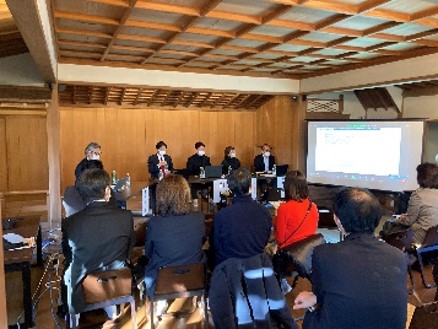
Panel Discussion of the Regional Revitalization Symposium
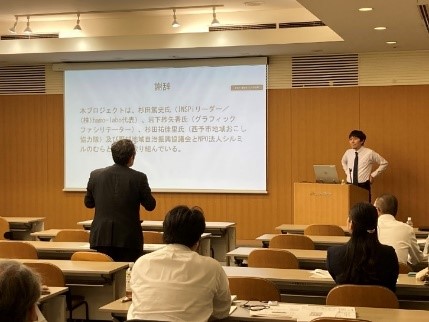
The Presentation Session on the Papers & Research of Civil Engineering Practices
【Reported by Keiichi Imai, Chair, Committee on Civil Engineering Consultants (CTI Engineering Co., Ltd.)】
Updates
◆The International Infrastructure Archives
– A Compilation of Japan’s Greatest Projects in Transfer of Civil Engineering Technology in Service –
http://www.jsce.or.jp/e/archive/
◆2023 JSCE Annual Meeting
https://www.jsce-int.org/event/annual
◆JSCE Online Joint Seminar on Fly Ash and Blast Furnace Slag Blended Cement Concrete
https://www.jsce-int.org/node/836
◆IAC “News Pick Up!!” on the JSCE Japanese website
https://committees.jsce.or.jp/kokusai/iac_dayori_2023
◆Summary of featured articles in JSCE Magazine Vol. 108, No.9, September 2023
http://www.jsce-int.org/pub/magazine
◆Journal of JSCE
https://www.jstage.jst.go.jp/browse/journalofjsce
◆The 4th Asian Concrete Federation (ACF) Symposium on Emerging Technologies for Structural Longevity (ACF2022_ETSL): https://acf2022.aconf.org/index.html
◆CECAR10:http://www.cecar10.org/
◆ASCE 2023 CONVENTION, CHICAGO (October, 18-21)
https://convention.asce.org/
◆KSCE 2023 CONVENTION, YEOSE (October, 18-20)
https://eng.ksce.or.kr/activities/act01.asp?idx=60&page=1&sfield=>xt=&...
Subcription
The IAC News is one of the communication tools to share information and ideas with the members. We would like to invite you, your friends and colleagues to join the communication and to subscribe the IAC News. Please register online: (http://www.jsce-int.org/node/150). We look forward to meeting you.
